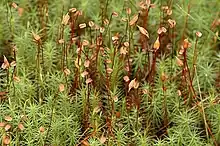| Polytrichaceae Temporal range: | |
|---|---|
 | |
| Polytrichum commune | |
| Scientific classification | |
| Kingdom: | Plantae |
| Division: | Bryophyta |
| Class: | Polytrichopsida Doweld |
| Order: | Polytrichales M. Fleisch. |
| Family: | Polytrichaceae Schwägr. |
| Genera | |
|
See text. | |
Polytrichaceae is a common family of mosses. Members of this family tend to be larger than other mosses with a thickened central stem and a rhizome. The leaves have a midrib that bears photosynthetic lamellae on the upper surface. Species in this group are dioicous. Another characteristic that identifies them is that they have from 32 to 64 peristome teeth in their sporangium.
Classification
class Polytrichopsids
|
| |||||||||||||||||||||||||||||||||||||||
| The phylogenetic position of the Polytrichaceae among the eight classes of mosses, based on inferences from DNA sequence data.[1][2] |
Genera

Atrichum undulatum
- Alophosia
- Atrichopsis
- Atrichum
- Bartramiopsis
- Dawsonia
- Dendroligotrichum
- Hebantia
- Itatiella
- Lyellia
- Meiotrichum
- Notoligotrichum
- Oligotrichum
- Plagioracelopus
- Pogonatum
- Polytrichadelphus
- Polytrichastrum
- Polytrichum
- Pseudatrichum
- Psilopilum
- Steereobryon
Extinct genera
- †Eopolytrichum Konopka et al., 1997 Cretaceous (Campanian); Gaillard Formation, Georgia, USA
- †Meantoinea Bippus et al., 2017 Cretaceous (Valanginian); Apple Bay locality, Vancouver Island, British Columbia, Canada
- †Polytrichites Britton, 1926 Miocene; Latah Formation, Washington, USA[3]
References
- ↑ Goffinet, B.; W. R. Buck & A. J. Shaw (2008). "Morphology and Classification of the Bryophyta". In Bernard Goffinet & A. Jonathan Shaw (eds.). Bryophyte Biology (2nd ed.). Cambridge: Cambridge University Press. pp. 55–138. ISBN 9780521872256.
- ↑ Goffinet, Bernard; William R. Buck (2004). "Systematics of the Bryophyta (Mosses): From molecules to a revised classification". Monographs in Systematic Botany. Molecular Systematics of Bryophytes. Missouri Botanical Garden Press. 98: 205–239. ISBN 1-930723-38-5.
- ↑ Knowlton, F.H. (1926). "Flora of the Latah Formation of Spokane, Washington, and Coeur d'Alene, Idaho". Shorter contributions to general geology, 1925 (PDF) (Report). Professional Paper. Vol. 140. United States Geological Survey. pp. 17–55, plates VIII-XXXI. doi:10.3133/pp140A.
This article is issued from Wikipedia. The text is licensed under Creative Commons - Attribution - Sharealike. Additional terms may apply for the media files.